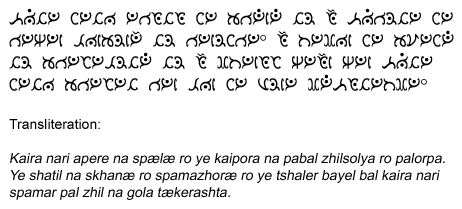Nari alphabet 
The Nari alphabet is the creation by Thomas Slawson (thbslawson@yahoo.com).
It grew out a fascination with and study of various languages. Thomas is currently
also developing an accompanying storyline of the imaginary people who will
speak the Nari language. He has based the grammar of Nari on concepts borrowed
from English, Hebrew, Russian and a few other languages, but has tried to keep
the grammar very simple, avoiding exceptions and strange morphologies. He has
endeavored with the words, however, to ‘compose’ completely new words, and has
strived not to consciously borrow from other languages.
Thomas is a musician by practice (a composer specifically), and so his purpose
was to focus on inventing words according to how he thought they should sound.
Obviously this will result in the language being influenced by his culture and
worldview, but that can’t be avoided anyway.
Notable features
- The alphabet is arranged according to sounds. Vowels all have both a
long sound and a soft sound, with the ae and ai diphthong sounds having their
own letters. The next set of letters are the "gutterals" (g, kh, k, r, khr),
all of which are produced in the back of the throat. The next set he
calls "tonals" (b, d, l, m, n, zh) because a definite "hum" is made
when pronouncing them. The next set he calls "atonals" (f, p, s, sh, t) because
they have more "airy" sound. The final letter (the v) is in a class by itself,
because its pronunciation lies between a tonal and an atonal, so he calls it
a "semitonal".
Nari alphabet

Sample text

Translation
All human beings are born free and equal in dignity and rights. They
are endowed with reason and conscience and should act towards one another
in a spirit of brotherhood.
(Article 1 of the Universal Declaration of Human Rights)
